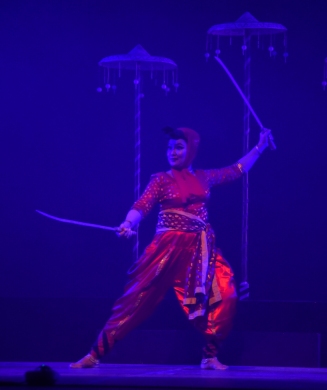
|   |

|   |
Imaginative visualization of Tagore's Chitrangada in Assamese - Dr. S.D. Desai e-mail: sureshmrudula@gmail.com April 5, 2018 Rabindranath Tagore created with his vision and lyric poetry in Bengali, the character of Chitrangada. He gave universal contemporary contours to the Chitrangada of the Mahabharata. Anjana Moyee Saikia of Darpan, Guwahati, under the direction of Abinash Sarma, brought on stage last Friday at the Theatre Olympics, Ahmedabad (Tagore Hall), that character as a flesh and blood person with a distinctive identity modern women anywhere in the world would find endearing. In Anjana's own pleasingly imaginative choreography, Chitrangada based on Madhurima Barua's Assamese adaptation is an exhilarating 80-minute visualization of the dainty original. Theatre lovers must have seen many versions of Tagore's classic work hailed as an epic. A poem does not become a mahakavi by its length. It becomes one with the poetry it is invested with, the treatment of its theme and portrayals of characters. With all these traits, Tagore's short dramatic piece has an appeal transcending time. Darpan's visual interpretation of Chitrangada has its power acquired with a sensitive depiction of its central character and creative collaborative contributions made by other elements of theatre, notably the light design (Kaushik Borbora) and the musical score along with sounds (Yachinur Rahman).
Dancer and choreographer Anjana, who has also designed costumes that often turn symbolically connotative, uses more than one classical dance form. Soft and lyrical Manipuri is her mainstay. Among other forms employed are Sattriya with the abandon associated with it, Odissi mudras and body language besides Kathak footwork and movement. The initial Yogasanas and the martial Thang-ta movements give the presentation a special traditional charm. The classical forms do not necessarily appear distinguishable separately. At times the forms blend. Abandoning her manly attire - she was raised and trained as a warrior prince - Chitrangada for the first time enters fully attired white, displaying her delicate feminine charm with Arjuna in the centre upstage indifferent to it doing dhyaan. For a while she is in the alluring tribhanga and mudras characteristic to Odissi. What follows is in lyrical Manipuri, the form of the land dripping feminine grace. With Arjuna showing unconcern for her and her pranaya nivedana - an incomplete purusha in the otherwise harmonious scheme of nature - the simple narrative ends and the complex theme starts asserting itself.  Dejected and let down but not ready to give up, Chitrangada transforms herself. Madana is at work in Vasant with his bow and arrow made of flowers. The process of her transformation from valorous manliness to delicate femininity is not directly seen on the stage. That is another innovative aspect of the production. A bevy of dancing smiling girls keeps appearing from time to time in a supporting role on stage with and without the central character. The girls smartly demonstrate at this stage Chitrangada doing shringara backstage. As expected, the nayika reappears, now attired green with relief in gold, her face and whole being glowing with confidence and dignity, singing tarangit hey praan... Soon we find Arjuna overcome by passion transforming too, melting like snow. The culmination is in the ethereal images of vaagarthaaviv samprukthau saayujya, conjured up by Anjana and Sasank, so beautiful with exceptionally powerful lights and music no rasika would have liked to take eyes away from even for a while. Purusha-Prakriti union is integral to the divine scheme of the universe. A woman is created empowered by nature. There is no need for her to try to be like a man. Chitrangada in the production, incidentally, is so powerful she overshadows Arjuna. In the beginning, he is seen losing balance in his action and perhaps he needed a little more attention. Overall, there is a balance between tending to be spectacular and being lyrical. Dr. S.D. Desai, a professor of English, has been a Performing Arts Critic for many years. Among the dance journals he has contributed to are Narthaki, Sruti, Nartanam and Attendance. His books have been published by Gujarat Sahitya Academy, Oxford University Press and Rupa. After 30 years with a national English daily, he is now a freelance art writer. |